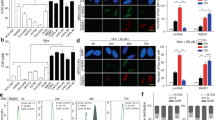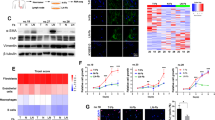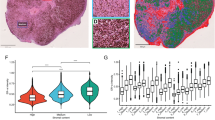Abstract
Multiple drug resistance is a challenging issue in the clinic. There is growing evidence that the G-protein-coupled estrogen receptor (GPER) is a novel mediator in the development of multidrug resistance in both estrogen receptor (ER)-positive and -negative breast cancers, and that cancer-associated fibroblasts (CAFs) in the tumor microenvironment may be a new agent that promotes drug resistance in tumor cells. However, the role of cytoplasmic GPER of CAFs on tumor therapy remains unclear. Here we first show that the breast tumor cell-activated PI3K/AKT (phosphoinositide 3-kinase/AKT) signaling pathway induces the cytoplasmic GPER translocation of CAFs in a CRM1-dependent pattern, and leads to the activation of a novel estrogen/GPER/cAMP/PKA/CREB signaling axis that triggers the aerobic glycolysis switch in CAFs. The glycolytic CAFs feed the extra pyruvate and lactate to tumor cells for augmentation of mitochondrial activity, and this energy metabolically coupled in a ‘host–parasite relationship’ between catabolic CAFs and anabolic cancer cells confers the tumor cells with multiple drug resistance to several conventional clinical treatments including endocrine therapy (tamoxifen), Her-2-targeted therapy (herceptin) and chemotherapy (epirubicin). Moreover, the clinical data from 18F-fluorodeoxyglucose positron emission tomography/computed tomography further present a strong association between the GPER/cAMP/PKA/CREB pathway of stromal fibroblasts with tumor metabolic activity and clinical treatment, suggesting that targeting cytoplasmic GPER in CAFs may rescue the drug sensitivity in patients with breast cancer. Thus, our data define novel insights into the stromal GPER-mediated multiple drug resistance from the point of reprogramming of tumor energy metabolism and provide the rationale for CAFs as a promising target for clinical therapy.
This is a preview of subscription content, access via your institution
Access options
Subscribe to this journal
Receive 50 print issues and online access
$259.00 per year
only $5.18 per issue
Buy this article
- Purchase on Springer Link
- Instant access to full article PDF
Prices may be subject to local taxes which are calculated during checkout








Similar content being viewed by others
References
Fan L, Strasser-Weippl K, Li JJ St, Louis J, Finkelstein DM, Yu KD et al. Breast cancer in China. Lancet Oncol 2014; 15: e279–e289.
Kalluri R . Basement membranes: structure, assembly and role in tumour angiogenesis. Nat Rev Cancer 2003; 3: 422–433.
de Kruijf EM, van Nes JG, van de Velde CJ, Putter H, Smit VT, Liefers GJ et al. Tumor–stroma ratio in the primary tumor is a prognostic factor in early breast cancer patients, especially in triple-negative carcinoma patients. Breast Cancer Res Treat 2011; 125: 687–696.
Ahn S, Cho J, Sung J, Lee JE, Nam SJ, Kim KM et al. The prognostic significance of tumor-associated stroma in invasive breast carcinoma. Tumour Biol 2012; 33: 1573–1580.
Hu M, Yao J, Carroll DK, Weremowicz S, Chen H, Carrasco D et al. Regulation of in situ to invasive breast carcinoma transition. Cancer Cell 2008; 13: 394–406.
Tang X, Hou Y, Yang G, Wang X, Tang S, Du YE et al. Stromal miR-200s contribute to breast cancer cell invasion through CAF activation and ECM remodeling. Cell Death Differ 2016; 23: 132–145.
Kalluri R, Zeisberg M . Fibroblasts in cancer. Nat Rev Cancer 2006; 6: 392–401.
Yager JD, Davidson NE . Estrogen carcinogenesis in breast cancer. N Engl J Med 2006; 354: 270–282.
Scaling AL, Prossnitz ER, Hathaway HJ . GPER mediates estrogen-induced signaling and proliferation in human breast epithelial cells and normal and malignant breast. Horm Cancer 2014; 5: 146–160.
Yu T, Liu M, Luo H, Wu C, Tang X, Tang S et al. GPER mediates enhanced cell viability and motility via non-genomic signaling induced by 17β-estradiol in triple-negative breast cancer cells. J Steroid Biochem Mol Biol 2014; 143: 392–403.
Mo Z, Liu M, Yang F, Luo H, Li Z, Tu G et al. GPR30 as an initiator of tamoxifen resistance in hormone-dependent breast cancer. Breast Cancer Res 2013; 15: R114.
Luo H, Yang G, Yu T, Luo S, Wu C, Sun Y et al. GPER-mediated proliferation and estradiol production in breast cancer-associated fibroblasts. Endocr Relat Cancer 2014; 21: 355–369.
De Francesco EM, Pellegrino M, Santolla MF, Lappano R, Ricchio E, Abonante S et al. GPER mediates activation of HIF1α/VEGF signaling by estrogens. Cancer Res 2014; 74: 4053–4064.
Luttrell LM, Daaka Y, Lefkowitz RJ . Regulation of tyrosine kinase cascades by G-protein-coupled receptors. Curr Opin Cell Biol 1999; 11: 177–183.
Prossnitz ER, Arterburn JB, Smith HO, Oprea TI, Sklar LA, Hathaway HJ . Estrogen signaling through the transmembrane G protein-coupled receptor GPR30. Annu Rev Physiol 2008; 70: 165–190.
Fujiwara S, Terai Y, Kawaguchi H, Takai M, Yoo S, Tanaka Y et al. GPR30 regulates the EGFR-Akt cascade and predicts lower survival in patients with ovarian cancer. J Ovarian Res 2012; 5: 35.
Girgert R, Emons G, Gründker C . Inhibition of GPR30 by estriol prevents growth stimulation of triple-negative breast cancer cells by 17beta-estradiol. BMC Cancer 2014; 14: 935.
Bologa CG, Revankar CM, Young SM, Edwards BS, Arterburn JB, Kiselyov AS et al. Virtual and biomolecular screening converge on a selective agonist for GPR30. Nat Chem Biol 2006; 2: 207–212.
Dennis MK, Burai R, Ramesh C, Petrie WK, Alcon SN, Nayak TK et al. In vivo effects of a GPR30 antagonist. Nat Chem Biol 2009; 5: 421–427.
Ignatov A, Ignatov T, Roessner A, Costa SD, Kalinski T . Role of GPR30 in the mechanisms of tamoxifen resistance in breast cancer MCF-7 cells. Breast Cancer Res Treat 2010; 123: 87–96.
Filardo EJ, Graeber CT, Quinn JA, Resnick MB, Giri D, DeLellis RA et al. Distribution of GPR30, a seven membrane-spanning estrogen receptor, in primary breast cancer and its association with clinicopathologic determinants of tumor progression. Clin Cancer Res 2006; 12: 6359–6366.
Ignatov A, Ignatov T, Weissenborn C, Eggemann H, Bischoff J, Semczuk A et al. G-protein-coupled estrogen receptor GPR30 and tamoxifen resistance in breast cancer. Breast Cancer Res Treat 2011; 128: 457–466.
Madeo A, Maggiolini M . Nuclear alternate estrogen receptor GPR30 mediates 17β-estradiol-induced gene expression and migration in breast cancer-associated fibroblasts. Cancer Res 2010; 70: 6036–6046.
Filardo E, Quinn J, Pang Y, Graeber C, Shaw S, Dong J et al. Activation of the novel estrogen receptor G protein-coupled receptor 30 (GPR30) at the plasma membrane. Endocrinology 2007; 148: 3236–3245.
Cheng SB, Graeber CT, Quinn JA, Filardo EJ . Retrograde transport of the transmembrane estrogen receptor, G-protein-coupled-receptor-30 (GPR30/GPER) from the plasma membrane towards the nucleus. Steroids 2011; 76: 892–896.
Filardo EJ, Thomas P . Minireview: G protein-coupled estrogen receptor-1, GPER-1: its mechanism of action and role in female reproductive cancer, renal and vascular physiology. Endocrinology 2012; 153: 2953–2962.
Lin BC, Suzawa M, Blind RD, Tobias SC, Bulun SE, Scanlan TS et al. Stimulating the GPR30 estrogen receptor with a novel tamoxifen analogue activates SF-1 and promotes endometrial cell proliferation. Cancer Res 2009; 69: 5415–5423.
Pupo M, Vivacqua A, Perrotta I, Pisano A, Aquila S, Abonante S et al. The nuclear localization signal is required for nuclear GPER translocation and function in breast cancer-associated fibroblasts (CAFs). Mol Cell Endocrinol 2013; 376: 23–32.
Warburg O . On the origin of cancer cells. Science 1956; 123: 309–314.
Pavlides S, Whitaker-Menezes D, Castello-Cros R, Flomenberg N, Witkiewicz AK, Frank PG et al. The reverse Warburg effect: aerobic glycolysis in cancer associated fibroblasts and the tumor stroma. Cell Cycle 2009; 8: 3984–4001.
Martinez-Outschoorn UE, Goldberg A, Lin Z, Ko YH, Flomenberg N, Wang C et al. Anti-estrogen resistance in breast cancer is induced by the tumor microenvironment and can be overcome by inhibiting mitochondrial function in epithelial cancer cells. Cancer Biol Ther 2011; 12: 924–938.
Martinez-Outschoorn UE, Lin Z, Whitaker-Menezes D, Howell A, Lisanti MP, Sotgia F . Ketone bodies and two-compartment tumor metabolism: stromal ketone production fuels mitochondrial biogenesis in epithelial cancer cells. Cell Cycle 2012; 11: 3956–3963.
DeFranco DB . Nuclear export: DNA-binding domains find a surprising partner. Curr Biol 2001; 11: R1036–R1037.
Lombardi M, Castoria G, Migliaccio A, Barone MV, Di Stasio R, Ciociola A et al. Hormone-dependent nuclear export of estradiol receptor and DNA synthesis in breast cancer cells. J Cell Biol 2008; 182: 327–340.
Fornerod M, Ohno M, Yoshida M, Mattaj IW . CRM1 is an export receptor for leucine-rich nuclear export signals. Cell 1997; 90: 1051–1060.
Ji JY, Jing H, Diamond SL . Shear stress causes nuclear localization of endothelial glucocorticoid receptor and expression from the GRE promoter. Circ Res 2003; 92: 279–285.
Qiu M, Olsen A, Faivre E, Horwitz KB, Lange CA . Mitogen-activated protein kinase regulates nuclear association of human progesterone receptors. Mol Endocrinol 2003; 17: 628–642.
Mayr B, Montminy M . Transcriptional regulation by the phosphorylation-dependent factor CREB. Nat Rev Mol Cell Biol 2001; 2: 599–609.
Zhang X, Odom DT, Koo SH, Conkright MD, Canettieri G, Best J et al. Genome-wide analysis of cAMP-response element binding protein occupancy, phosphorylation, and target gene activation in human tissues. Proc Natl Acad Sci USA 2005; 102: 4459–4464.
Kim MY, Koh DI, Choi WI, Jeon BN, Jeong DY, Kim KS et al. ZBTB2 increases PDK4 expression by transcriptional repression of RelA/p65. Nucleic Acids Res 2015; 43: 1609–1625.
Dennison JB, Molina JR, Mitra S, González-Angulo AM, Balko JM, Kuba MG et al. Lactate dehydrogenase B: a metabolic marker of response to neoadjuvant chemotherapy in breast cancer. Clin Cancer Res 2013; 19: 3703–3713.
Kitajima K, Fukushima K, Miyoshi Y, Katsuura T, Igarashi Y, Kawanaka Y et al. Diagnostic and prognostic value of (18)F-FDG PET/CT for axillary lymph node staging in patients with breast cancer. Jpn J Radiol 2016; 34: 220–228.
Bonuccelli G, Whitaker-Menezes D, Castello-Cros R, Pavlides S, Pestell RG, Fatatis A et al. The reverse Warburg effect: glycolysis inhibitors prevent the tumor promoting effects of caveolin-1 deficient cancer associated fibroblasts. Cell Cycle 2010; 15: 1960–1971.
Whitaker-Menezes D, Martinez-Outschoorn UE, Lin Z, Ertel A, Flomenberg N, Witkiewicz AK et al. Evidence for a stromal-epithelial ‘lactate shuttle’ in human tumors: MCT4 is a marker of oxidative stress in cancer-associated fibroblasts. Cell Cycle 2011; 10: 1772–1783.
Lapensee EW, Tuttle TR, Fox SR, Ben-Jonathan N . Bisphenol A at low nanomolar doses confers chemoresistance in estrogen receptor-α-positive and -negative breast cancer cells. Environ Health Perspect 2009; 117: 175–180.
Liu Y, Du FY, Chen W, Fu PF, Yao MY, Zheng SS . G15 sensitizes epithelial breast cancer cells to doxorubicin by preventing epithelial–mesenchymal transition through inhibition of GPR30. Am J Transl Res 2015; 7: 967–975.
Vivacqua A, De Marco P, Santolla MF, Cirillo F, Pellegrino M, Panno ML et al. Estrogenic gper signaling regulates mir144 expression in cancer cells and cancer-associated fibroblasts (cafs). Oncotarget 2015; 6: 16573–16587.
Zucchetti AE, Barosso IR, Boaglio AC, Basiglio CL, Miszczuk G, Larocca MC et al. G-protein-coupled receptor 30/adenylyl cyclase/protein kinase A pathway is involved in estradiol 17β-d-glucuronide-induced cholestasis. Hepatology 2014; 59: 1016–1029.
Huang T, Civelek AC, Li J, Jiang H, Ng CK, Postel GC et al. Tumor microenvironment-dependent 18F-FDG,18F-fluorothymidine, and 18F-misonidazole uptake:a pilot study in mouse models of human non-small cell lung cancer. J Nucl Med 2012; 53: 1262–1268.
Farace P, D'Ambrosio D, Merigo F, Galiè M, Nanni C, Spinelli A et al. Cancer-associated stroma affects FDG uptake in experimental carcinomas. Implications for FDG-PET delineation of radiotherapy target. Eur J Nucl Med Mol Imaging 2009; 36: 616–623.
Zhang G, Li J, Wang X, Ma Y, Yin X, Wang F et al. The reverse Warburg effect and 18F-FDG Uptake in non-small cell lung cancer A549 in mice: a pilot study. J Nucl Med 2015; 56: 607–612.
Pugachev A, Ruan S, Carlin S, Larson SM, Campa J, Ling CC et al. Dependence of FDG uptake on tumor microenvironment. Int J Radiat Oncol Biol Phys 2005; 62: 545–553.
De Francesco EM, Lappano R, Santolla MF, Marsico S, Caruso A, Maggiolini M . HIF-1α/GPER signaling mediates the expression of VEGF induced by hypoxia in breast cancer associated fibroblasts (CAFs). Breast Cancer Res 2013; 15: R64.
Martinez-Outschoorn UE, Sotgia F, Lisanti MP . Power surge: supporting cells ‘fuel’ cancer cell mitochondria. Cell Metab 2012; 15: 4–5.
Alvero AB, Montagna MK, Sumi NJ, Joo WD, Graham E, Mor G . Multiple blocks in the engagement of oxidative phosphorylation in putative ovarian cancer stem cells: implication for maintenance therapy with glycolysis inhibitors. Oncotarget 2014; 5: 8703–8715.
Xie Q, Wu Q, Horbinski CM, Flavahan WA, Yang K, Zhou W et al. Mitochondrial control by DRP1 in brain tumor initiating cells. Nat Neurosci 2015; 18: 501–510.
Sotgia F, Martinez-Outschoorn UE, Howell A, Pestell RG, Pavlides S, Lisanti MP . Caveolin-1 and cancer metabolism in the tumor microenvironment: markers, models, and mechanisms. Annu Rev Pathol 2012; 7: 423–467.
Sotgia F, Martinez-Outschoorn UE, Pavlides S, Howell A, Pestell RG, Lisanti MP . Understanding the Warburg effect and the prognostic value of stromal caveolin-1 as a marker of a lethal tumor microenvironment. Breast Cancer Res 2011; 13: 213.
Das SK, Eder S, Schauer S, Diwoky C, Temmel H, Guertl B et al. Adipose triglyceride lipase contributes to cancer-associated cachexia. Science 2011; 333: 233–238.
Nieman KM, Kenny HA, Penicka CV, Ladanyi A, Buell-Gutbrod R, Zillhardt MR et al. Adipocytes promote ovarian cancer metastasis and provide energy for rapid tumor growth. Nat Med 2011; 17: 1498–1503.
Acknowledgements
This work was supported by National Natural Science Foundation of China (NSFC 81372398) (to GT) and by National Natural Science Foundation of China (NSFC 81472676, NSFC 31171336) (to ML).
Author information
Authors and Affiliations
Corresponding authors
Ethics declarations
Competing interests
The authors declare no conflict of interest.
Additional information
Supplementary Information accompanies this paper on the Oncogene website
Supplementary information
Rights and permissions
About this article
Cite this article
Yu, T., Yang, G., Hou, Y. et al. Cytoplasmic GPER translocation in cancer-associated fibroblasts mediates cAMP/PKA/CREB/glycolytic axis to confer tumor cells with multidrug resistance. Oncogene 36, 2131–2145 (2017). https://doi.org/10.1038/onc.2016.370
Received:
Revised:
Accepted:
Published:
Issue Date:
DOI: https://doi.org/10.1038/onc.2016.370
This article is cited by
-
cAMP-PKA/EPAC signaling and cancer: the interplay in tumor microenvironment
Journal of Hematology & Oncology (2024)
-
GPER-mediated stabilization of HIF-1α contributes to upregulated aerobic glycolysis in tamoxifen-resistant cells
Oncogene (2023)
-
The importance of being CAFs (in cancer resistance to targeted therapies)
Journal of Experimental & Clinical Cancer Research (2022)
-
Cancer-associated fibroblasts and resistance to anticancer therapies: status, mechanisms, and countermeasures
Cancer Cell International (2022)
-
High GPER expression in triple-negative breast cancer is linked to pro-metastatic pathways and predicts poor patient outcomes
npj Breast Cancer (2022)



